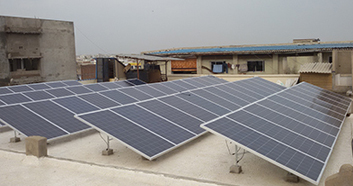With the growth of electronics, automation and equipment, India’s energy needs are burgeoning by the day and so is the cost for meeting those power demands. Given such a scenario, rooftop solar is a viable alternative.

Power is directly proportional to Growth
Power is a measure of unit energy required to do a unit work. It is the fundamental man-made ingredient to propel the evolution of human society and the development of our planet. Almost everything that we do, requires power. Every stroke of key on the keyboard while writing this article would have consumed a minute but certain amount of energy. The biggest power consumers in the world are either the biggest or the most developed countries. Which proves that the power needed to work out the highest growth will be highest.
With just over 1,000 units per capita annual consumption, India is last among the top 10 developing and developed countries. India’s per capita energy consumption is almost a third of the average per capita consumption to grow in contemporary world and almost one twelfth of nations like USA, Canada & China. These figures prove that India is going to need a lot more power than it currently produces to upkeep the growth, development and economy. This is going to be a mammoth task. And a lot of it is going to be powered by the microgrid or Rooftop Solar. Thus, rooftop solar is the key solution to contemporary power needs.
Where does India stand?
India accomplished 1 GW milestone for rooftop solar growth, which is about 113 percent growth in 2016 over 2015. Keeping in perspective that we have a target of achieving 40 GW by 2022, the current 1 GW capacity is an absolutely negligible achievement, so to say. Experts and analysts concluded that the rooftop potential in India is currently pegged at 1,24,000 MW. More than 30 per cent of this number can be easily achieved if 1.3% houses in India are made solar compatible. Major cities in India are still too slow to adopt solar.
To promote participation, the Government has recently offered 30 per cent subsidy for solar rooftop installation focused on net-metering. Also, 30 of the 36 states and Union Territories in India have agreed so far on net-metering policies. Even cities like Mumbai, Chennai and Delhi that have great potential for rooftop solar growth are yet to lead the rooftop revolution. This is also due to lack of shade free space in crowded Indian Metros and also because most people living in the metros still don’t own a roof.
Conventional Power Costs are Rising and solar is becoming cheaper
Furthermore, with the growth of electronics, automation and equipment, India’s energy needs are burgeoning by the day and so is the cost for meeting those power demands. Given such a scenario, rooftop solar seems to be a viable alternative. In India, 17% of the world’s population resides in 2.4% of the total land area of the world.
Thanks to the rising competition, solar rooftops are now quite low-cost. Additionally, the roof top solar plants do not have any moving parts which makes maintenance easier. On-grid systems are battery-free and therefore inexpensive if compared to the battery enabled counterparts. Maintenance cost is almost nil as residential installations runs for over 25 years and this covers investment costs easily. What’s more, the break even for an on-grid solar PV system is achieved in 5 years max, post the initial investment. Thus, installing solar rooftop panels from reliable energy providers can reduce household energy bills by upto 80%.
A $40 billion worth untapped opportunity
Let’s take a look at the statistics. Presently, 1 GW of the Indian solar rooftop capacity comprises 377 MW industrial, 263 MW commercial and around 260 MW residential installations. Thus, we can see that the maximum number of installations are limited to the large scale utility sector and commercial premises, thereby partly leaving out the common man from tapping into the immense solar potential that exists in India. This is an issue if we keep in mind that the primary purpose of solar is to take electricity into the remotest corner of the country. This also reflects that there are challenges that need immediate attention to enable common man’s access to Solar.
On-grid solar PV systems can take out electricity from the grid when the Sun is not available – such as during the nights or during heavy monsoons. Such systems also generate more power during the peak usage times. Such PV systems also reduces the distribution, transmission and conversion wastage as the energy is consumed at the point of generation, ensuring a stable power supply round the clock.
Rooftop solar plants, unlike parks, do not need large land spaces, there is no question of greenhouse gases or nuclear waste as is the case with thermal and nuclear plants, respectively. It is the greenest, cleanest, safest energy source and it is the only option for a country which is slated to house the world’s largest population by 2022.
There are around 300 million homes in India but only a few of them are equipped to hold solar panels. Agencies and the government can play a huge role in creating awareness for solar. With more public awareness than ever, lack of structured financing favorable policies are resisting growth. We need campaigns on the lines of ‘Sarv Shikhsa Abhiyan’ & ‘Polio Mission’ to make India a solar nation.
The GST effect – So far, the Indian solar industry has been levied ‘0’ percent tax in terms of excise duty, sales tax, basic and total custom duty. With GST, there is an inclusion of 5% tax on solar modules. The impact of this new tax would be rise in price of solar module manufacturing. The aftermath of this will be – domestics modules will end up being more costly than the foreign modules. Already, the indigenous ones are 8 to 10% costlier than their foreign counterparts.
If the Government is keen on achieving the energy target of 200 GW by 2022, major part of this target needs to come from rooftop solar. Proper planning and stringent implementation is needed to make the solar revolution happen and Government intervention will be needed at multiple levels.
Source By : ETEnergyworld.com



I want to run 5 HP waterpump in agriculture area and 640 watts in residential areas. What would be approx cost and how many panels of what size will be required? Pl guide with all details. .
Dear Customer,
Please call us on Toll Free : 1800 120 4011 . our team will give you all details